Purang Abolmaesumi
Diverse Prototypical Ensembles Improve Robustness to Subpopulation Shift
May 29, 2025Abstract:The subpopulationtion shift, characterized by a disparity in subpopulation distributibetween theween the training and target datasets, can significantly degrade the performance of machine learning models. Current solutions to subpopulation shift involve modifying empirical risk minimization with re-weighting strategies to improve generalization. This strategy relies on assumptions about the number and nature of subpopulations and annotations on group membership, which are unavailable for many real-world datasets. Instead, we propose using an ensemble of diverse classifiers to adaptively capture risk associated with subpopulations. Given a feature extractor network, we replace its standard linear classification layer with a mixture of prototypical classifiers, where each member is trained to classify the data while focusing on different features and samples from other members. In empirical evaluation on nine real-world datasets, covering diverse domains and kinds of subpopulation shift, our method of Diverse Prototypical Ensembles (DPEs) often outperforms the prior state-of-the-art in worst-group accuracy. The code is available at https://github.com/minhto2802/dpe4subpop
TRUSWorthy: Toward Clinically Applicable Deep Learning for Confident Detection of Prostate Cancer in Micro-Ultrasound
Feb 20, 2025Abstract:While deep learning methods have shown great promise in improving the effectiveness of prostate cancer (PCa) diagnosis by detecting suspicious lesions from trans-rectal ultrasound (TRUS), they must overcome multiple simultaneous challenges. There is high heterogeneity in tissue appearance, significant class imbalance in favor of benign examples, and scarcity in the number and quality of ground truth annotations available to train models. Failure to address even a single one of these problems can result in unacceptable clinical outcomes.We propose TRUSWorthy, a carefully designed, tuned, and integrated system for reliable PCa detection. Our pipeline integrates self-supervised learning, multiple-instance learning aggregation using transformers, random-undersampled boosting and ensembling: these address label scarcity, weak labels, class imbalance, and overconfidence, respectively. We train and rigorously evaluate our method using a large, multi-center dataset of micro-ultrasound data. Our method outperforms previous state-of-the-art deep learning methods in terms of accuracy and uncertainty calibration, with AUROC and balanced accuracy scores of 79.9% and 71.5%, respectively. On the top 20% of predictions with the highest confidence, we can achieve a balanced accuracy of up to 91%. The success of TRUSWorthy demonstrates the potential of integrated deep learning solutions to meet clinical needs in a highly challenging deployment setting, and is a significant step towards creating a trustworthy system for computer-assisted PCa diagnosis.
Cinepro: Robust Training of Foundation Models for Cancer Detection in Prostate Ultrasound Cineloops
Jan 21, 2025Abstract:Prostate cancer (PCa) detection using deep learning (DL) models has shown potential for enhancing real-time guidance during biopsies. However, prostate ultrasound images lack pixel-level cancer annotations, introducing label noise. Current approaches often focus on limited regions of interest (ROIs), disregarding anatomical context necessary for accurate diagnosis. Foundation models can overcome this limitation by analyzing entire images to capture global spatial relationships; however, they still encounter challenges stemming from the weak labels associated with coarse pathology annotations in ultrasound data. We introduce Cinepro, a novel framework that strengthens foundation models' ability to localize PCa in ultrasound cineloops. Cinepro adapts robust training by integrating the proportion of cancer tissue reported by pathology in a biopsy core into its loss function to address label noise, providing a more nuanced supervision. Additionally, it leverages temporal data across multiple frames to apply robust augmentations, enhancing the model's ability to learn stable cancer-related features. Cinepro demonstrates superior performance on a multi-center prostate ultrasound dataset, achieving an AUROC of 77.1% and a balanced accuracy of 83.8%, surpassing current benchmarks. These findings underscore Cinepro's promise in advancing foundation models for weakly labeled ultrasound data.
Reliable Multi-View Learning with Conformal Prediction for Aortic Stenosis Classification in Echocardiography
Sep 15, 2024Abstract:The fundamental problem with ultrasound-guided diagnosis is that the acquired images are often 2-D cross-sections of a 3-D anatomy, potentially missing important anatomical details. This limitation leads to challenges in ultrasound echocardiography, such as poor visualization of heart valves or foreshortening of ventricles. Clinicians must interpret these images with inherent uncertainty, a nuance absent in machine learning's one-hot labels. We propose Re-Training for Uncertainty (RT4U), a data-centric method to introduce uncertainty to weakly informative inputs in the training set. This simple approach can be incorporated to existing state-of-the-art aortic stenosis classification methods to further improve their accuracy. When combined with conformal prediction techniques, RT4U can yield adaptively sized prediction sets which are guaranteed to contain the ground truth class to a high accuracy. We validate the effectiveness of RT4U on three diverse datasets: a public (TMED-2) and a private AS dataset, along with a CIFAR-10-derived toy dataset. Results show improvement on all the datasets.
Federated Impression for Learning with Distributed Heterogeneous Data
Sep 11, 2024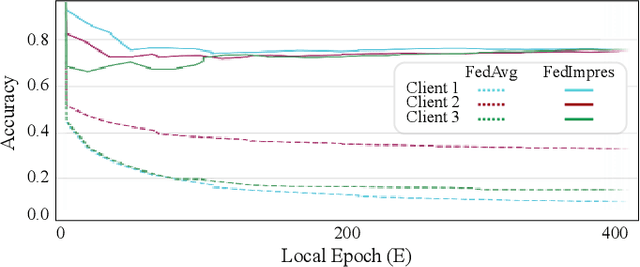
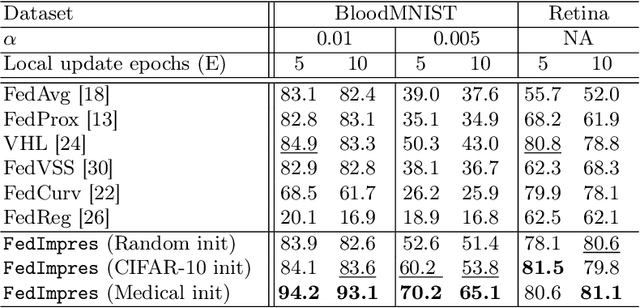
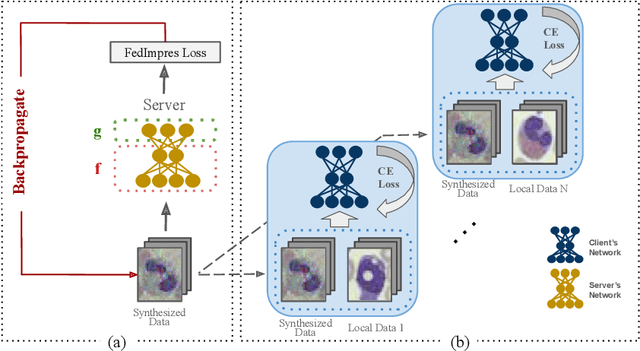

Abstract:Standard deep learning-based classification approaches may not always be practical in real-world clinical applications, as they require a centralized collection of all samples. Federated learning (FL) provides a paradigm that can learn from distributed datasets across clients without requiring them to share data, which can help mitigate privacy and data ownership issues. In FL, sub-optimal convergence caused by data heterogeneity is common among data from different health centers due to the variety in data collection protocols and patient demographics across centers. Through experimentation in this study, we show that data heterogeneity leads to the phenomenon of catastrophic forgetting during local training. We propose FedImpres which alleviates catastrophic forgetting by restoring synthetic data that represents the global information as federated impression. To achieve this, we distill the global model resulting from each communication round. Subsequently, we use the synthetic data alongside the local data to enhance the generalization of local training. Extensive experiments show that the proposed method achieves state-of-the-art performance on both the BloodMNIST and Retina datasets, which contain label imbalance and domain shift, with an improvement in classification accuracy of up to 20%.
Calibrated Diverse Ensemble Entropy Minimization for Robust Test-Time Adaptation in Prostate Cancer Detection
Jul 17, 2024Abstract:High resolution micro-ultrasound has demonstrated promise in real-time prostate cancer detection, with deep learning becoming a prominent tool for learning complex tissue properties reflected on ultrasound. However, a significant roadblock to real-world deployment remains, which prior works often overlook: model performance suffers when applied to data from different clinical centers due to variations in data distribution. This distribution shift significantly impacts the model's robustness, posing major challenge to clinical deployment. Domain adaptation and specifically its test-time adaption (TTA) variant offer a promising solution to address this challenge. In a setting designed to reflect real-world conditions, we compare existing methods to state-of-the-art TTA approaches adopted for cancer detection, demonstrating the lack of robustness to distribution shifts in the former. We then propose Diverse Ensemble Entropy Minimization (DEnEM), questioning the effectiveness of current TTA methods on ultrasound data. We show that these methods, although outperforming baselines, are suboptimal due to relying on neural networks output probabilities, which could be uncalibrated, or relying on data augmentation, which is not straightforward to define on ultrasound data. Our results show a significant improvement of $5\%$ to $7\%$ in AUROC over the existing methods and $3\%$ to $5\%$ over TTA methods, demonstrating the advantage of DEnEM in addressing distribution shift. \keywords{Ultrasound Imaging \and Prostate Cancer \and Computer-aided Diagnosis \and Distribution Shift Robustness \and Test-time Adaptation.}
CCSI: Continual Class-Specific Impression for Data-free Class Incremental Learning
Jun 09, 2024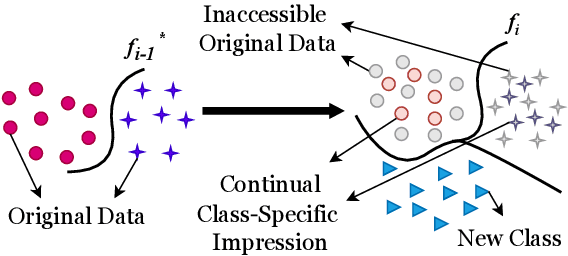

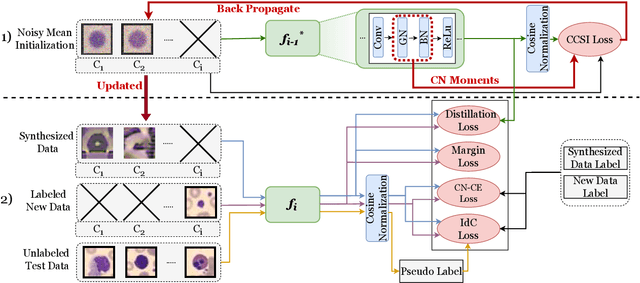
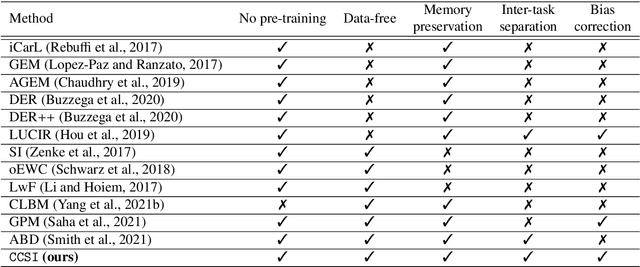
Abstract:In real-world clinical settings, traditional deep learning-based classification methods struggle with diagnosing newly introduced disease types because they require samples from all disease classes for offline training. Class incremental learning offers a promising solution by adapting a deep network trained on specific disease classes to handle new diseases. However, catastrophic forgetting occurs, decreasing the performance of earlier classes when adapting the model to new data. Prior proposed methodologies to overcome this require perpetual storage of previous samples, posing potential practical concerns regarding privacy and storage regulations in healthcare. To this end, we propose a novel data-free class incremental learning framework that utilizes data synthesis on learned classes instead of data storage from previous classes. Our key contributions include acquiring synthetic data known as Continual Class-Specific Impression (CCSI) for previously inaccessible trained classes and presenting a methodology to effectively utilize this data for updating networks when introducing new classes. We obtain CCSI by employing data inversion over gradients of the trained classification model on previous classes starting from the mean image of each class inspired by common landmarks shared among medical images and utilizing continual normalization layers statistics as a regularizer in this pixel-wise optimization process. Subsequently, we update the network by combining the synthesized data with new class data and incorporate several losses, including an intra-domain contrastive loss to generalize the deep network trained on the synthesized data to real data, a margin loss to increase separation among previous classes and new ones, and a cosine-normalized cross-entropy loss to alleviate the adverse effects of imbalanced distributions in training data.
Benchmarking Image Transformers for Prostate Cancer Detection from Ultrasound Data
Mar 27, 2024Abstract:PURPOSE: Deep learning methods for classifying prostate cancer (PCa) in ultrasound images typically employ convolutional networks (CNNs) to detect cancer in small regions of interest (ROI) along a needle trace region. However, this approach suffers from weak labelling, since the ground-truth histopathology labels do not describe the properties of individual ROIs. Recently, multi-scale approaches have sought to mitigate this issue by combining the context awareness of transformers with a CNN feature extractor to detect cancer from multiple ROIs using multiple-instance learning (MIL). In this work, we present a detailed study of several image transformer architectures for both ROI-scale and multi-scale classification, and a comparison of the performance of CNNs and transformers for ultrasound-based prostate cancer classification. We also design a novel multi-objective learning strategy that combines both ROI and core predictions to further mitigate label noise. METHODS: We evaluate 3 image transformers on ROI-scale cancer classification, then use the strongest model to tune a multi-scale classifier with MIL. We train our MIL models using our novel multi-objective learning strategy and compare our results to existing baselines. RESULTS: We find that for both ROI-scale and multi-scale PCa detection, image transformer backbones lag behind their CNN counterparts. This deficit in performance is even more noticeable for larger models. When using multi-objective learning, we can improve performance of MIL, with a 77.9% AUROC, a sensitivity of 75.9%, and a specificity of 66.3%. CONCLUSION: Convolutional networks are better suited for modelling sparse datasets of prostate ultrasounds, producing more robust features than transformers in PCa detection. Multi-scale methods remain the best architecture for this task, with multi-objective learning presenting an effective way to improve performance.
GEMTrans: A General, Echocardiography-based, Multi-Level Transformer Framework for Cardiovascular Diagnosis
Aug 25, 2023



Abstract:Echocardiography (echo) is an ultrasound imaging modality that is widely used for various cardiovascular diagnosis tasks. Due to inter-observer variability in echo-based diagnosis, which arises from the variability in echo image acquisition and the interpretation of echo images based on clinical experience, vision-based machine learning (ML) methods have gained popularity to act as secondary layers of verification. For such safety-critical applications, it is essential for any proposed ML method to present a level of explainability along with good accuracy. In addition, such methods must be able to process several echo videos obtained from various heart views and the interactions among them to properly produce predictions for a variety of cardiovascular measurements or interpretation tasks. Prior work lacks explainability or is limited in scope by focusing on a single cardiovascular task. To remedy this, we propose a General, Echo-based, Multi-Level Transformer (GEMTrans) framework that provides explainability, while simultaneously enabling multi-video training where the inter-play among echo image patches in the same frame, all frames in the same video, and inter-video relationships are captured based on a downstream task. We show the flexibility of our framework by considering two critical tasks including ejection fraction (EF) and aortic stenosis (AS) severity detection. Our model achieves mean absolute errors of 4.15 and 4.84 for single and dual-video EF estimation and an accuracy of 96.5 % for AS detection, while providing informative task-specific attention maps and prototypical explainability.
Manifold DivideMix: A Semi-Supervised Contrastive Learning Framework for Severe Label Noise
Aug 13, 2023



Abstract:Deep neural networks have proven to be highly effective when large amounts of data with clean labels are available. However, their performance degrades when training data contains noisy labels, leading to poor generalization on the test set. Real-world datasets contain noisy label samples that either have similar visual semantics to other classes (in-distribution) or have no semantic relevance to any class (out-of-distribution) in the dataset. Most state-of-the-art methods leverage ID labeled noisy samples as unlabeled data for semi-supervised learning, but OOD labeled noisy samples cannot be used in this way because they do not belong to any class within the dataset. Hence, in this paper, we propose incorporating the information from all the training data by leveraging the benefits of self-supervised training. Our method aims to extract a meaningful and generalizable embedding space for each sample regardless of its label. Then, we employ a simple yet effective K-nearest neighbor method to remove portions of out-of-distribution samples. By discarding these samples, we propose an iterative "Manifold DivideMix" algorithm to find clean and noisy samples, and train our model in a semi-supervised way. In addition, we propose "MixEMatch", a new algorithm for the semi-supervised step that involves mixup augmentation at the input and final hidden representations of the model. This will extract better representations by interpolating both in the input and manifold spaces. Extensive experiments on multiple synthetic-noise image benchmarks and real-world web-crawled datasets demonstrate the effectiveness of our proposed framework. Code is available at https://github.com/Fahim-F/ManifoldDivideMix.
 Add to Chrome
Add to Chrome Add to Firefox
Add to Firefox Add to Edge
Add to Edge